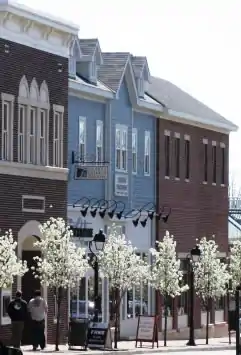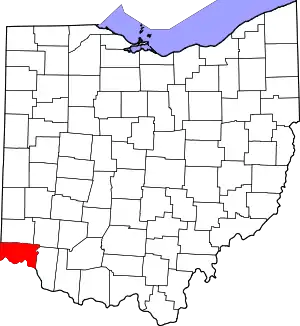Montgomery, Ohio | |
|---|---|
 Downtown | |
 Location in Hamilton County and the state of Ohio | |
| Coordinates: 39°14′50″N 84°20′51″W / 39.24722°N 84.34750°W | |
| Country | United States |
| State | Ohio |
| County | Hamilton |
| Government | |
| • Mayor | Craig Margolis[1] |
| Area | |
| • Total | 5.32 sq mi (13.78 km2) |
| • Land | 5.31 sq mi (13.75 km2) |
| • Water | 0.01 sq mi (0.03 km2) |
| Elevation | 801 ft (244 m) |
| Population (2020) | |
| • Total | 10,853 |
| • Estimate (2022)[4] | 10,773 |
| • Density | 2,045.03/sq mi (789.58/km2) |
| Time zone | UTC-5 (Eastern (EST)) |
| • Summer (DST) | UTC-4 (EDT) |
| ZIP code | 45242 |
| Area code | 513 |
| FIPS code | 39-51716[5] |
| GNIS feature ID | 1065047[3] |
| Website | www |
Montgomery is a city in Hamilton County, Ohio, United States. It is an eastern suburb of Cincinnati. The population was 10,853 at the 2020 census.
History
Settled in 1795, Montgomery is one of the oldest settlements in Hamilton County. A log cabin was the first tavern of the community; this was a resting place for teamsters and travelers on the main road. In 1806-7 a number of people from Montgomery, New York settled around this point for trade and farming, and named the village for their former home.[6]
The town became a coach stop on the Cincinnati-Zanesville Road, later known as the Montgomery Pike, with an inn, two taverns, a grist mill and a carding mill to process its agricultural products. It remained a hamlet until the 1960s when it became a bedroom community for people working in Cincinnati.[7]
During the COVID-19 pandemic Montgomery held a "reverse parade", setting up floats in Sycamore High School's parking lot and having residents drive by.[8] The event made international news.[9]
Geography
Montgomery is located at 39°14′50″N 84°20′51″W / 39.24722°N 84.34750°W (39.247359, -84.347556).[10]
According to the United States Census Bureau, the city has a total area of 5.30 square miles (13.73 km2), of which 5.29 square miles (13.70 km2) is land and 0.01 square miles (0.03 km2) is water.[11]
Demographics
| Census | Pop. | Note | %± |
|---|---|---|---|
| 1920 | 378 | — | |
| 1930 | 394 | 4.2% | |
| 1940 | 461 | 17.0% | |
| 1950 | 579 | 25.6% | |
| 1960 | 3,075 | 431.1% | |
| 1970 | 5,683 | 84.8% | |
| 1980 | 10,084 | 77.4% | |
| 1990 | 9,753 | −3.3% | |
| 2000 | 10,163 | 4.2% | |
| 2010 | 10,251 | 0.9% | |
| 2020 | 10,853 | 5.9% | |
| 2022 (est.) | 10,773 | −0.7% | |
| Sources:[5][12][13][14] | |||
2020 census
As of the census of 2020, there were 10,853 people living in the city, for a population density of 2,045.03 people per square mile (789.58/km2). There were 4,102 housing units. The racial makeup of the city was 84.6% White, 2.7% Black or African American, 0.1% Native American, 6.6% Asian, 0.0% Pacific Islander, 0.7% from some other race, and 5.3% from two or more races. 3.6% of the population were Hispanic or Latino of any race.[15]
There were 4,029 households, out of which 33.8% had children under the age of 18 living with them, 66.4% were married couples living together, 11.9% had a male householder with no spouse present, and 19.1% had a female householder with no spouse present. 25.8% of all households were made up of individuals, and 19.0% were someone living alone who was 65 years of age or older. The average household size was 2.61, and the average family size was 3.19.[15]
27.3% of the city's population were under the age of 18, 50.8% were 18 to 64, and 21.9% were 65 years of age or older. The median age was 44.0. For every 100 females, there were 96.9 males.[15]
According to the U.S. Census American Community Survey, for the period 2016-2020 the estimated median annual income for a household in the city was $131,856, and the median income for a family was $165,000. About 1.5% of the population were living below the poverty line, including 0.6% of those under age 18 and 4.5% of those age 65 or over. About 62.5% of the population were employed, and 77.2% had a bachelor's degree or higher.[15]
2010 census
As of the census[16] of 2010, there were 10,251 people, 3,849 households, and 2,940 families living in the city. The population density was 1,937.8 inhabitants per square mile (748.2/km2). There were 4,055 housing units at an average density of 766.5 per square mile (295.9/km2). The racial makeup of the city was 89.9% White, 2.7% African American, 0.1% Native American, 5.6% Asian, 0.4% from other races, and 1.4% from two or more races. Hispanic or Latino of any race were 1.8% of the population.
There were 3,849 households, of which 34.8% had children under the age of 18 living with them, 68.5% were married couples living together, 5.9% had a female householder with no husband present, 1.9% had a male householder with no wife present, and 23.6% were non-families. 21.2% of all households were made up of individuals, and 12.6% had someone living alone who was 65 years of age or older. The average household size was 2.60 and the average family size was 3.04.
The median age in the city was 46.9 years. 25.3% of residents were under the age of 18; 4.8% were between the ages of 18 and 24; 16.7% were from 25 to 44; 33.3% were from 45 to 64; and 19.9% were 65 years of age or older. The gender makeup of the city was 48.1% male and 51.9% female.
2000 census
As of the census[5] of 2000, there were 10,163 people, 3,616 households, and 2,943 families living in the city. The population density was 1,908.7 inhabitants per square mile (737.0/km2). There were 3,716 housing units at an average density of 697.9 per square mile (269.5/km2). The racial makeup of the city was 94.00% White, 1.57% African American, 0.05% Native American, 3.26% Asian, 0.10% from other races, and 1.02% from two or more races. Hispanic or Latino of any race were 0.77% of the population.
There were 3,616 households, out of which 39.0% had children under the age of 18 living with them, 74.8% were married couples living together, 4.8% had a female householder with no husband present, and 18.6% were non-families. 16.7% of all households were made up of individuals, and 8.6% had someone living alone who was 65 years of age or older. The average household size was 2.75 and the average family size was 3.11.
In the city, the population was spread out, with 28.1% under the age of 18, 4.1% from 18 to 24, 22.1% from 25 to 44, 30.1% from 45 to 64, and 15.5% who were 65 years of age or older. The median age was 43 years. For every 100 females, there were 93.4 males. For every 100 females age 18 and over, there were 88.1 males.
The median income for a household in the city was $89,224, and the median income for a family was $100,158. Males had a median income of $78,881 versus $45,000 for females. The per capita income for the city was $45,460. About 2.0% of families and 2.8% of the population were below the poverty line, including 3.2% of those under age 18 and 1.2% of those age 65 or over.
Education
Montgomery is served by the Sycamore Community School District which has received the highest rating from the state of Ohio ten consecutive years. Sycamore Community School District also serves Blue Ash, Ohio and Symmes Township, Hamilton County, Ohio. The city is also served by the private schools of Moeller High School for boys and Ursuline Academy for girls. Montgomery lies within the Great Oaks joint vocational school district.
Notable people
- Jane French, singer and songwriter
- Paul O'Neill, Major League Baseball player
- Connie Pillich, Ohio state representative
- Daniel von Bargen, actor
- John B. Weller, governor of California
- Harland Whitmore, economist
- Rose Lavelle, USWNT Soccer Player
Sister cities
Montgomery has one sister city, as designated by the Sister Cities International:
References
- ↑ "Mayor Craig Margolis - Montgomery, Ohio". City of Montgomery, Ohio. Retrieved March 3, 2023.
- ↑ "ArcGIS REST Services Directory". United States Census Bureau. Retrieved September 20, 2022.
- 1 2 "US Board on Geographic Names". United States Geological Survey. October 25, 2007. Retrieved January 31, 2008.
- ↑ "QuickFacts Montgomery city, Ohio". United States Census Bureau. Retrieved September 26, 2023.
- 1 2 3 "U.S. Census website". United States Census Bureau. Retrieved January 31, 2008.
- ↑ Clarke, S. J. (1912). Cincinnati, the Queen City, 1788-1912, Volume 2. The S. J. Clarke Publishing Company. p. 532. Retrieved May 20, 2013.
- ↑ "Montgomery, Ohio", Ohio History Central
- ↑ "This Reverse Parade Will Allow July Fourth Revelry From A Social Distance". NPR.org. Retrieved July 5, 2020.
- ↑ "Why this 4 July will be unlike any other". BBC News. July 2, 2020. Retrieved July 5, 2020.
- ↑ "US Gazetteer files: 2010, 2000, and 1990". United States Census Bureau. February 12, 2011. Retrieved April 23, 2011.
- ↑ "US Gazetteer files 2010". United States Census Bureau. Archived from the original on July 2, 2012. Retrieved January 6, 2013.
- ↑ "Population: Ohio" (PDF). 1930 US Census. U.S. Census Bureau. Retrieved November 28, 2013.
- ↑ "Number of Inhabitants: Ohio" (PDF). 18th Census of the United States. U.S. Census Bureau. 1960. Retrieved April 24, 2020.
- ↑ "Ohio: Population and Housing Unit Counts" (PDF). U.S. Census Bureau. Retrieved November 22, 2013.
- 1 2 3 4 "Montgomery city, Ohio - Census Bureau Profile". United States Census Bureau. Retrieved October 2, 2023.
- ↑ "U.S. Census website". United States Census Bureau. Retrieved January 6, 2013.
